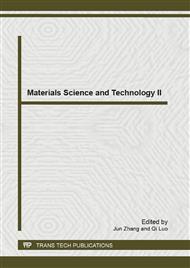[1]
E.D. Whitney: Ceramic Cutting Tools. William Andrew Publishing/Noyes, p.353, 1994.
Google Scholar
[2]
J.Zajac, et.al.:Cutting facilities of new type of came cutting material. In: Proceedings of the conference PPTO, Košice, 1995, pp.138-139.
Google Scholar
[3]
K.Vasilko: Analytical theory of splinter machining, Prešov FVT, p.338, 2007.
Google Scholar
[4]
M.Neslušan.et.al.: Experimental methods in splinter machining. EDIS ŽU Žilina, p.343,2007.
Google Scholar
[5]
M. Zelenak, J. Valicek, J. Brumek, P. Hlavacek, B. Haluzikova, M. Vylezik, P. Babkova, M. Harnicarova, V. Szarkova, M. Kusnerova, V. Kubena: Measurement and analysis of the hardnees of aluminium surface layers by the nanoindentation and scratch tests. 2011, Chemické Listy 105, 688-691.
Google Scholar
[6]
R. Cep, et.al: Ceramic cutting tool tests with interrupted cut simulator, In: IN-TECH 2010: Proceedings of International Conference on Inovative Technologies: Praha : 14. - 16. 9.2010. - Jaroměř : Tisk AS, 2010 pp.144-148. - ISBN 978-80-904502-2-6
Google Scholar
[7]
A. Panda-J.Duplák-J.Jurko-M. Behún: Comprehensive Identification of Sintered Carbide Durability in Machining Process of Bearings Steel 100CrMn6. Advanced Materials Research, Trans Tech Publications, Zurich, vol. 340, pp.30-33, ISSN 1022-6680, (2012)
DOI: 10.4028/www.scientific.net/amr.340.30
Google Scholar
[8]
A.Panda-J.Duplák-J.JURKO: Analytical expression of T-vc dependence in standard ISO 3685 for cutting ceramic. Key Engineering Materials, Trans Tech Publications, Zurich, 317-322 p.
DOI: 10.4028/www.scientific.net/kem.480-481.317
Google Scholar
[9]
J.Jurko-A.Panda-M.Gajdoš: Accompanying phenomena in the cutting zone machinability during turning of stainless steels. International Journal Machining and Machinability of Materials, INDERSCENCE Publisher, Vol.5, No.4, 2009, 383-400 p.
DOI: 10.1504/ijmmm.2009.026899
Google Scholar
[10]
J.Jurko-A.Panda: Study on screw drill wear when drilling a new stainless steel X02Cr18Ni10MoTiN and accompanying phenomena in the cutting zone. Advanced Materials Research, Vol.314-316, 995-998 p. (2011)
DOI: 10.4028/www.scientific.net/amr.314-316.995
Google Scholar
[11]
I.Leššo-P.Flegner-M.Šujanský-E.Špak: Research of the possibility of application of vector quantisation method for effective process control of rocks desintegration by rotary drilling. Metalurgija. Vol. 49, no. 1, pp.61-65. Croatian Metallurgical Society. ISSN 0543-5846, (2010)
Google Scholar
[12]
I.Mrkvica: Neue Beschichtung für die Zahnrad-Bearbeitung. VDI-Z, 145, Nr. 11/12, pp.46-49. (2003)
Google Scholar
[13]
T. Zaborowski, Ekowytwarzanie. Gorzow, p.100 (2007)
Google Scholar
[14]
J. Mačala, I. Pandová: Natural zeolite-clinoptilolite-raw material serviceable in the reduction of toxical components at combustion engines noxious gases. Gospodarka surowcami mineralnymi, vol. 23, no. 4, 2007, pp.19-25.
DOI: 10.2478/v10269-012-0015-1
Google Scholar
[15]
J.Jurko: Verification of surface finish as an indicator of machinability in turning steel X6Cr16Ni10MoTiN, Advanced Materials Research. Vol.291-294, 2987-2990 p. (2011)
DOI: 10.4028/www.scientific.net/amr.291-294.2987
Google Scholar
[16]
J.Jurko: The use of TiAlN coated carbide tool when finish drilling of stainless steel X4Cr17ni8TiN. Applied Mechanics and Materials, Vol.39, 369-374 p.
DOI: 10.4028/www.scientific.net/amm.39.369
Google Scholar
[17]
J. Novak-Marcincin, M. Janak, L. Novakova-Marcincinova, V. Fecova: Possibility of a quick check on milling strategy suitability. In: Technical Gazette 19 , no. 4, 2012, Univ. Osijek, Tech Fac, Slavonski Brod, Croatia, vol. 19, 2012, pp.959-964.
DOI: 10.1063/1.4707641
Google Scholar
[18]
I.Pandová, T. Gondová, K. Dubayová: Natural and modified clinoptilolite testing for reduction of harmful substance in manufacturing exploitation. In: Advanced Materials Research, Trans Tech Publications Inc., vol. 518-523, no. 518-523, 2012, pp.1757-1760.
DOI: 10.4028/www.scientific.net/amr.518-523.1757
Google Scholar
[19]
M. Zelenak, J. Valicek, S. Hloch, D. Kozak, I. Samardzic, M. Harnicarova, J. Klich, P. Hlavacek, R. Cincio: Comparison of mechanical properties of surface layers with use of nanoindentation and microindentation tests. 2012, Metalurgija 51(3): 309-312.
Google Scholar
[20]
K.Monková, P.Monka: The study conditions improvement by electronic guides utilization. In: 11-th international multidisciplinary scientific geoconference, SGEM 2011, vol. III, Albena, Bulgaria, 20.-25.6.2011, pp.1301-1307
DOI: 10.5593/sgem2011/s23.113
Google Scholar
[21]
P.Semančo, M.Fedák, M. Rimár, E. Ragan: Equation model to evaluate fluidity of aluminum alloys under pressure die-casting conditions with an application. In: Advanced Materials Research. Vol. 505 (2012), pp.190-194.
DOI: 10.4028/www.scientific.net/amr.505.190
Google Scholar
[22]
T.Krenický, M. Rimár: Monitoring of vibrations in the technology of AWJ. In: Key Engineering Materials. Vol. 496 (2012), pp.229-234.
DOI: 10.4028/www.scientific.net/kem.496.229
Google Scholar
[23]
Ľ.Straka, I.Čorný, J.Boržíková: Analysis of heat-affected zone depth of sample surface at electrical discharge machining with brass wire electrode. In: Strojarstvo: journal for Theory and Application in Mechanical Engineering. Vol. 51, no.6, 2009, pp.633-640.
Google Scholar
[24]
S.Adamczak, W.Makiela, K.Janusiewicz, K. Stepien: Statistical validation of the method for measuring radius variations of components on the machine tool. In: Metrology and Measuring Systems. Vol.18, no.1(2011), pp.35-46.
DOI: 10.2478/v10178-011-0004-5
Google Scholar


